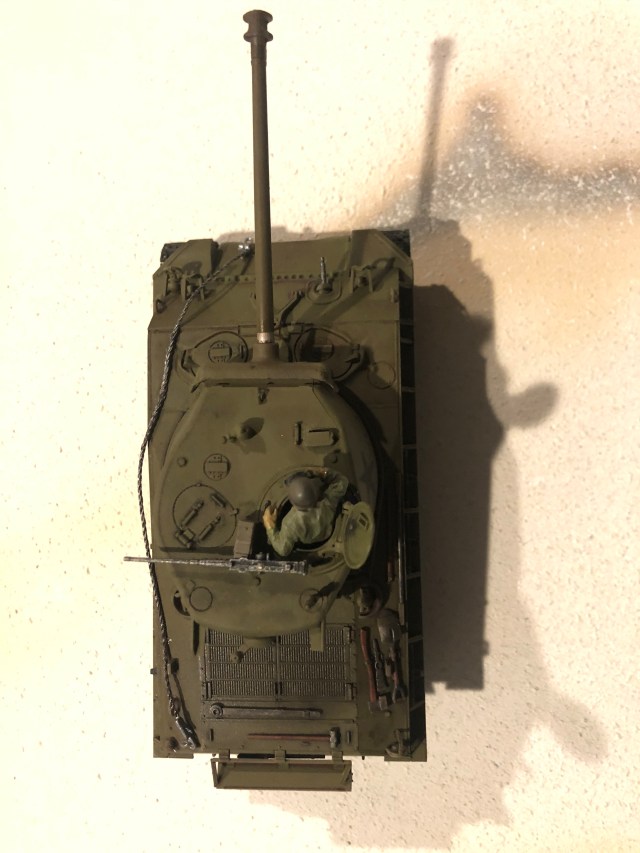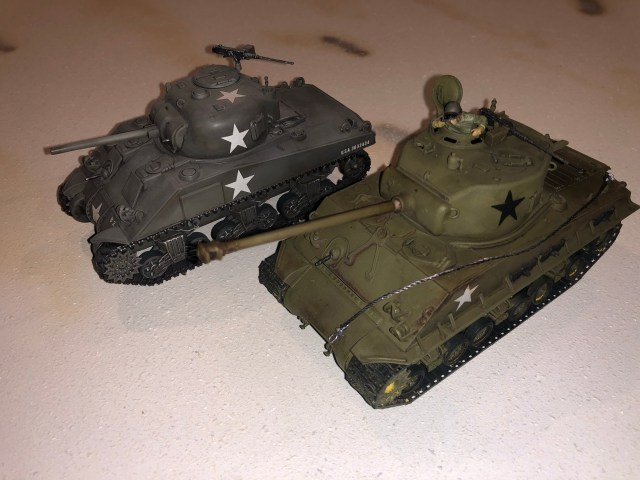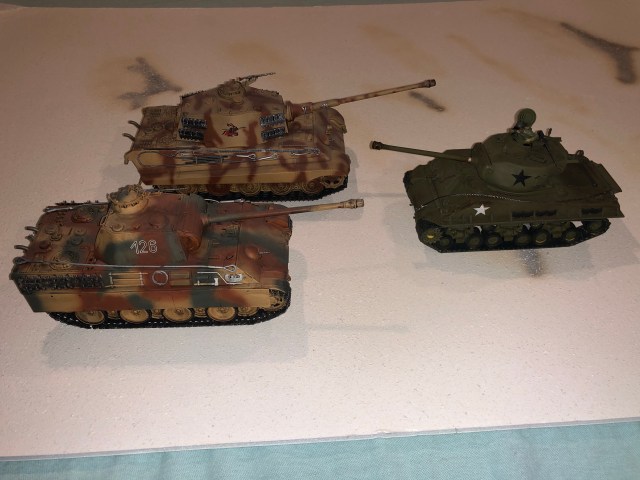Easy Eight
I’ve visited the Sherman tank here before. With nearly 50000 built it is the second most produced tank history behind only the Soviet T-34.

But previously we discussed the early production M4, this time we’ll look at the most fully evolved form of the design.
One complaint leveled against the Sherman is that its design was locked too early. That means, for the sake of mass production the design was committed to with only minor changes allowed to enable a rapid build up of the type. Although the design was actually quite modern in 1942, by 1944 the Germans were fielding an array of much bigger and deadlier armored fighting vehicles.


So much modern criticism of the Sherman comes from this fact. A basic M4 Sherman with its 75mm main gun could not face a Tiger, or even a Panther on equal terms.
The usual counter argument has to do with the Sherman’s vastly better reliability and ease of maintenance. Add to that a superior support and supply system and its not hard to see how the Sherman was a war winning weapon; even if it wasn’t quite as dangerous as newer and bigger tanks.


But the Sherman was improved over the course of the war. It was up-armored, both in terms of thickness and better slopes to reduce square hits and shot traps. Ammunition was put in armored ammo boxes that drastically reduced interior fires and explosions.
The main gun was replaced with a 76mm gun. This may sound like a small improvement over a 75 mm; but this was a better gun all around. The installation was somewhat pooched, the gun barrel was shortened from the prototype for weight and balance reasons which lessened the potential. But even so, the gun was an improvement. (The British put an even better gun on some of their Shermans, but I’ll save that story for another build).

This is the photo I most wanted to post. You can see the growth from a early to late Sherman. Look at the shape of the front glacius. Its angle is more sloped and the crew positions are behind a single armored slab. The older Sherman shown here has had armor appliques added over those crew positions and on the sides where ammunition was stored. The newer Sherman just has thicker integral armor. The turret shape has been redesigned to accommodate a bigger gun and improve crew function. And you can just see the wider track.
These improvements came with a cost. What they called “flotation”, the more modern term would be ground pressure. Basically, the Sherman had fairly narrow tracks which always gave it less off-road capability than some German designs. There were some cheap fixes to widen the tracks, but better was needed. So an all new suspension was designed. Originally the Sherman used suspension identified by the elegant name of Vertical Volute Spring Suspension, usually written as VVSS. A new bogey unit was designed that was named Horizontal Volute Spring Suspension or HVSS. Just rolls off the tongue, right? Most importantly, this allowed for a much wider track and smoother ride over a wide range of terrain. The last 2600 Shermans built used this type of suspension. But it didn’t generate a new designation, it was just tagged “experimental device 8” or “E8” on the end of the tank’s designator. Crews loved this change and took to calling their mount the “Easy Eight”.
This version of the Sherman entered service in November of 1944.

The Sherman was most equal to the Panzer IV, which was still the main German tank to the end of the War.
Which leads to this tank. Patton’s Third Army first took delivery of Easy Eights when they were preparing for their December offensive south of the Ardennes. When the Germans launched their great offensive on December 16 Patton may have had his greatest moment by simply pivoting his offensive to the north into the German flank and relieving a siege at Bastogne. This was not only a testament to the qualities of American fighting men who could adapt on the fly; but said a great deal about the quality of American armor that could drive fairly long distances quickly and with very few maintenance related problems.
This tank was a part of Patton’s 4th Armored division and was in Bastogne in January of 1945.

Okay, no doubt the German cats are bigger and badder. But they were also less numerous and much less reliable. I’ve seen kill ratios as either 1.1:1 or 3:2 in the Sherman’s favor. I’m sure there all sorts of qualifications on the details of how those numbers were arrived at, but either way forget that silly “5 Shermans equal 1 Tiger” nonsense you’ve seen on The History Channel.
This is the Tamiya kit.

It certainly was a war winning tank. Reliable and easily maintained, that alone outshone the complex German examples.
Absolutely!
As ever, superb models! There’s a lengthy discussion at the address below about the Sherman. It’s quite interesting although every person seems to have a different point of view. It just shows how difficult it is to extract the truth seventy five years after the event, with fewer and fewer witnesses around to tell the tale :
https://forum.axishistory.com/viewtopic.php?t=217773
Events passing from human memory is certainly becoming an issue. But of course “anecdotal” proofs are suspect too.
The discussion you linked is interesting, and it looks like it mostly points towards the idea there was never anything seriously wrong with the Sherman. Apart from the fact it was a wartime vehicle that occasionally suffered catastrophic damage…
Working with models, I thought you would have been interested in my last post.
I believe I read and liked the post for a Jeep restorer. Did I miss a post? Or just fail to hit the like button?
Perhaps it was my mistake, but did this information help with modelers, such as yourself?
Oh yes definitely. Pictures of the real thing help in any circumstance. And if you add in well informed data about equipment changes, colors, markings its gold.
Your specific post focusing on markings was particularly interesting since you were looking an odd-duck sort of unit (11th Airborne). I’m generally more knowledgeable on aircraft and know what rules were in use and when they were likely broken; so its particularly nice to have a resource on a vehicle.
I posted a Jeep a year or so ago here that was 101st airborne, but that was apparently more “by the book”. Except, all the decal stenciling was in white. I knew there was a change during the war, but hadn’t realized it was so late! I built the kit as it came, if I’d known the switch to white came in February of ’45 I would have looked for a source in pale blue! Of course maybe, maybe, the markings had been redone at a depot that didn’t follow standards. Yeah that’s it, that’s my story and I’m sticking to it…